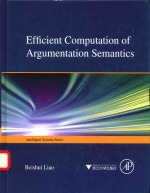

辩论推理系统的语义计算 英文版PDF电子书下载
- 电子书积分:8 积分如何计算积分?
- 作 者:廖备水著
- 出 版 社:杭州:浙江大学出版社
- 出版年份:2015
- ISBN:9787308143257
- 页数:144 页
1 Introduction 1
1.1 Background 1
1.2 The Notion of Argumentation 2
1.3 Motivations of This Book 4
1.4 The Structure of This Book 6
References 7
2 Semantics of Argumentation 9
2.1 Introduction 9
2.2 Abstract Argumentation Frameworks 10
2.3 Argumentation Emantics 10
2.3.1 Extension-Based Approach 11
2.3.2 Labelling-Based Approach 17
2.3.3 Relations Between the Two Approaches 21
2.3.4 Relations Between Difierent Semantics 22
2.3.5 Status of Arguments 22
2.4 Conclusions 24
References 25
3 Existing Approaches for Computing Argumentation Semantics 27
3.1 Introduction 27
3.2 Approaches Based on Answer-Set Programming 28
3.2.1 Answer-Set Programming 28
3.2.2 ASP for Argumentation 29
3.3 Labelling-Based Algorithms 32
3.3.1 The Computation of Grounded Labelling 32
3.3.2 The Computation of Preferred Labellings 33
3.4 Conclusions 36
References 37
4 Sub-Frameworks and Local Semantics 39
4.1 Introduction 39
4.2 Notion of Sub-Frameworks 40
4.2.1 Informal Idea 40
4.2.2 Formal Definition 41
4.2.3 Dependence Relation Between Different Sub-Frameworks 43
4.3 Semantics of Sub-Frameworks 44
4.3.1 Labellings of a Conditioned Sub-Framework 44
4.3.2 Extensions of a Conditioned Sub-Framework 47
4.4 Computation of the Semantics of a Sub-Framework 50
4.5 Conclusions 53
References 53
5 Relations Between Global Semantics and Local Semantics 55
5.1 Introduction 55
5.2 Mapping Global Semantics to Local Semantics 57
5.3 Mapping Local Semantics to Global Semantics 60
5.3.1 Combining Extensions of Two Unconditioned Sub-Frameworks 61
5.3.2 Combining Extensions of a Conditioned Sub-Framework and Those of an Unconditioned Sub-Framework 63
5.3.3 Combining Labellings of Two Conditioned Sub-Frameworks 69
5.4 Conclusions 72
References 72
6 An Approach for Static Argumentation Frameworks 73
6.1 Introduction 73
6.2 Decomposing an Argumentation Framework:a Layered Approach 75
6.2.1 Strongly Connected Components(SCCs)of an Argumentation Framework 76
6.2.2 A Decomposition Approach Based on SCCs 76
6.3 An Incremental Approach to Compute Argumentation Semantics 81
6.3.1 The Computation ofLayer i(0≤i≤lmax) 81
6.3.2 Soundness and Completeness of Semantic Combination 84
6.3.3 An Illustrating Example 85
6.4 Empirical Evaluation 89
6.5 Conclusions 96
References 98
7 An Approach for Dynamic Argumentation Frameworks 101
7.1 Introduction 101
7.2 The Changing of an Argumentation Framework 105
7.3 The Division of an Updated Argumentation Framework 106
7.4 Computing the Semantics of an Updated Argumentation Framework Based on the Division 111
7.5 An Illustrating Example 112
7.6 Conclusions 114
References 116
8 An Approach for Partial Semantics of Argumentation 119
8.1 Introduction 119
8.2 The Definition of Partial Semantics of Argumentation 121
8.3 Basic Properties of Partial Semantics of Argumentation 124
8.3.1 Monotonicity of Partial Semantics 125
8.3.2 Extensibility of PartiaI Semantics 125
8.3.3 Combinability of Partial Semantics 128
8.4 Empirical Investigation 129
8.5 Conclusions 134
References 135
9 Conclusions and Future Work 137
9.1 Conclusions 137
9.2 Future Work 138
References 139
Index 141
- 《计算机网络与通信基础》谢雨飞,田启川编著 2019
- 《大学计算机实验指导及习题解答》曹成志,宋长龙 2019
- 《卓有成效的管理者 中英文双语版》(美)彼得·德鲁克许是祥译;那国毅审校 2019
- 《计算机辅助平面设计》吴轶博主编 2019
- 《计算机组成原理解题参考 第7版》张基温 2017
- 《云计算节能与资源调度》彭俊杰主编 2019
- 《Helmholtz方程的步进计算方法研究》李鹏著 2019
- 《AutoCAD 2018自学视频教程 标准版 中文版》CAD/CAM/CAE技术联盟 2019
- 《跟孩子一起看图学英文》张紫颖著 2019
- 《计算机组成原理 第2版》任国林 2018
- 《完美的合同 合同的基本原理及审查与修改 第3版=THE PERFECT CONTRACT (THIRD EDITION)》吴江水著 2020
- 《从零开始学水墨风景画 1》(日)松井阳水著 2018
- 《中国货币史研究二种》章宗元,徐沧水著 2013
- 《家教忌语》邵泽水著 1997
- 《楼兰迷踪 荒漠高楼》上善若水著 2012
- 《东篱拾趣》李水著 2010
- 《不如我们重新来过》吴沉水著 2013
- 《天使不哭》纤云若水著 2014
- 《龙陵秘藏》上善若水著 2013
- 《生态价值概论》胡安水著 2013
- 《大学计算机实验指导及习题解答》曹成志,宋长龙 2019
- 《浙江海岛植物原色图谱》蒋明,柯世省主编 2019
- 《大学生心理健康与人生发展》王琳责任编辑;(中国)肖宇 2019
- 《大学英语四级考试全真试题 标准模拟 四级》汪开虎主编 2012
- 《大学英语教学的跨文化交际视角研究与创新发展》许丽云,刘枫,尚利明著 2020
- 《复旦大学新闻学院教授学术丛书 新闻实务随想录》刘海贵 2019
- 《大学英语综合教程 1》王佃春,骆敏主编 2015
- 《美丽浙江 2016 法语》浙江省人民政府新闻办公室编 2016
- 《二十五史中的浙江人 24》浙江省地方志编纂委员会编 2005
- 《大学物理简明教程 下 第2版》施卫主编 2020
